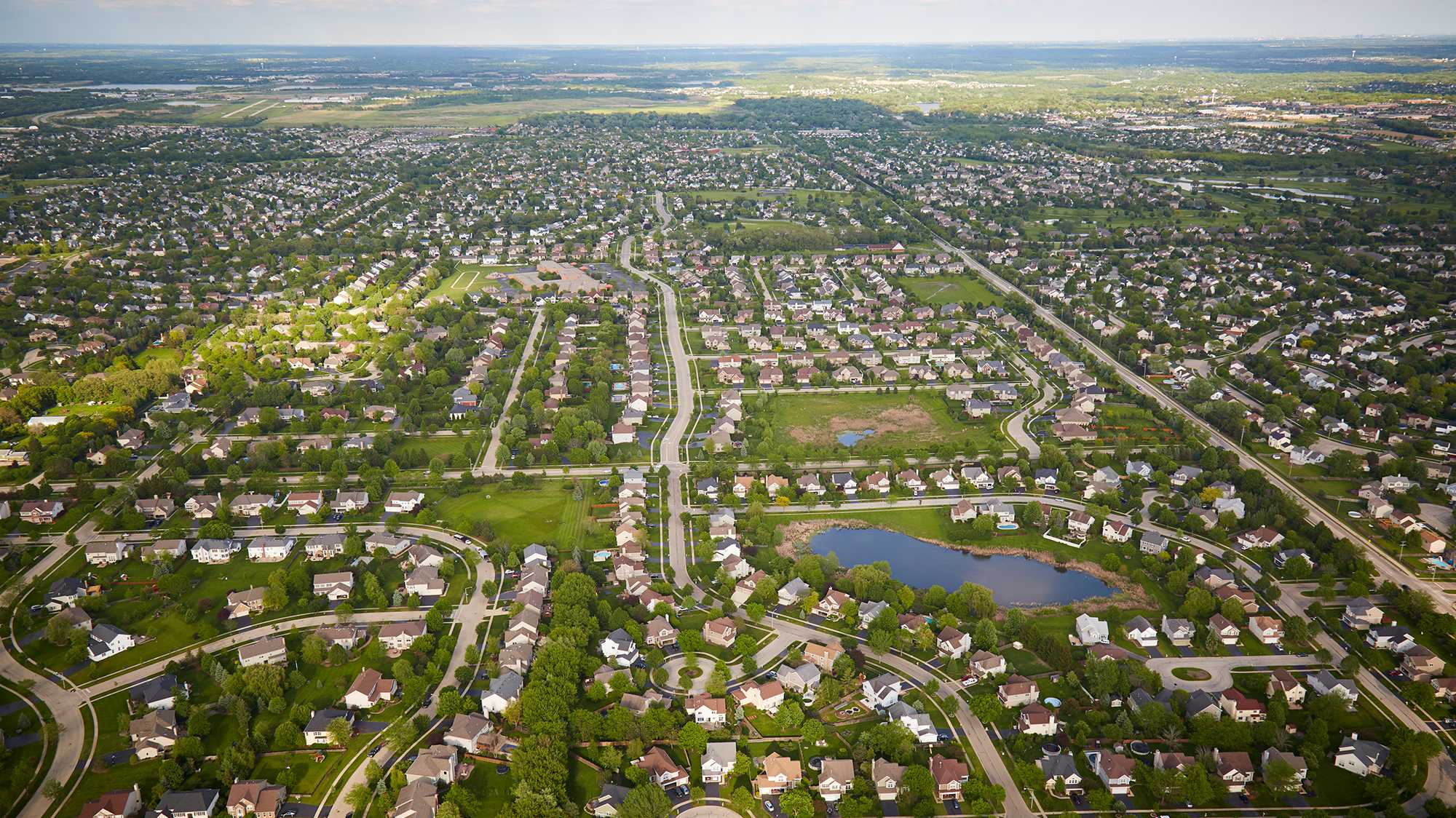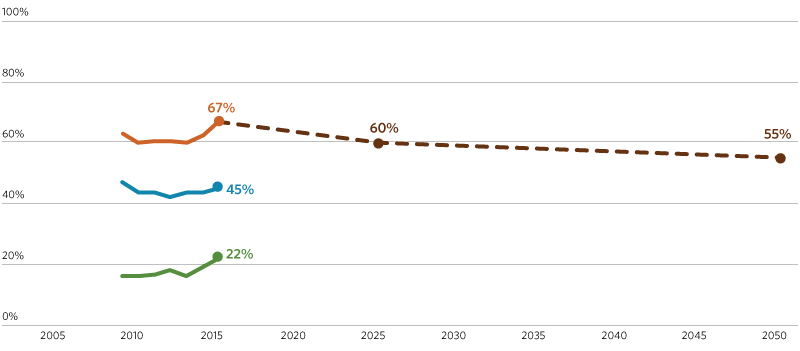Recommendation
Match regional and local housing supply with types that residents want

The region’s housing supply must adapt to meet global shifts and local needs that include an aging population, increasing diversity, and changing living patterns. As demographics change, so does the type and location of the housing that people want. Research found that the market can be impeded from meeting such changes in demand by various barriers, including both the community's lack of alignment between planning, zoning, and approvals processes and the extent to which its residents accept proposed housing developments.
Strategies
The current lack of sufficient housing options makes our residential market vulnerable to shifting demand, contributes to concentrated poverty, and hurts the health of residents. The disconnect between the housing that people want and what is available undermines the regional economy. In the CMAP region, as in many others across the nation, minorities, people with disabilities, and people in poverty are often concentrated geographically. According to recent analysis by the Metropolitan Planning Council, the Chicago region has the fifth highest combination of racial and economic segregation among the 100 largest U.S. regions. This combined segregation by race and income is highly detrimental to residents within these geographies and to the entire region because of negative consequences associated with concentrated poverty. For example, health researchers have found that where people are born, grow up, live, work, and age has a major impact on physical, mental, and behavioral health outcomes. To compete in the future, metropolitan Chicago must make full use of all its resources, especially its residents. Yet because our region struggles to build a sufficient amount of good, affordable and accessible housing with access to employment and services, the deleterious effects of segregation and concentrated poverty continue. To name just one outcome, the fact that residents of EDAs are less likely to be homeowners limits the region's potential for wealth building, which in turn limits the financial resources available for local and regional initiatives.

By 2050, residents in our region should have the ability to find a good, affordable and accessible home that fits each household’s preferences, including proximity to jobs, transportation, and other amenities, throughout all stages of life. Today, transportation costs are rising and commutes for low income residents are long. ON TO 2050 sets a goal of reducing housing and transportation costs for low and moderate-income residents, to improve housing choice and quality of life. To reach that vision, stakeholders throughout the region must address barriers that prevent the market from meeting the demand of current and future residents. Housing choice will help make our residential stock resilient in the face of changing demand, help reduce concentrated poverty, and improve affordability and accessibility for all residents, including low- and moderate-income households.
- Housing
- Transportation
- Housing + Transportation
- Targets

The following describes strategies and associated action to implement this recommendation.
Create and disseminate best practices for promoting community consensus
Addressing barriers to housing choice requires support from municipal leaders, community-based organizations, and residents. Such buy-in can be hard to get. No individual organization in our region has the alignment of mission and capacity to single handedly cultivate support for expanded housing options in general, and for affordable housing in particular. Certainly, CMAP alone does not. But the work of Impact DuPage, DuPage United, and Lake County United shows promise, and all three rely on a similar approach: creating local support for additional housing types through grassroots organizing often led by religious organizations, social service providers, and concerned residents.
Form local grassroots organizations that galvanize support for the development of a broader range of housing types.
Religious organizations, social service providers, and concerned residents
Monitor the success of nascent community consensus efforts and share lessons learned as those in other parts of the region embark on their own efforts.
Partners
Align zoning, approval processes, building codes, and inspections to generate more housing options
Changes in demographics and consumer behavior are transforming the types, locations, and price points of people's housing preferences. Evidenced in the earlier chart showing the proportion of permitted new housing units in the Chicago Metropolitan Statistical Area by units in structure, the region is changing from building mostly single-family detached units to an equal balance of the multi-unit developments. This change is occurring in many parts of the region – not just the City of Chicago – reflecting the demand for more housing options. To prepare for continued shifts, communities should be planning for future housing needs. By forging consensus on which housing types should be developed locally, communities may avoid the contentiousness that can ensue when the public reviews a specific development proposal that has caught residents by surprise. Such planning can also help local leaders understand the relationship between community desires and market realities. And especially when the plans cross jurisdictions, they can help multiple communities come together to create unified responses to mutual challenges. The recently developed Regional Housing Solutions website provides local stakeholders with proven market-specific tools to address pressing local housing issues.
Yet planning alone is not enough. Meeting regulatory requirements is often a sequential process, with the cost of each added step driving up home prices. Through zoning, entitlement processes, and building codes and inspections, municipalities' and counties' choices shape the types of housing that can be built and preserved. These and other regulations can limit housing options that the market might otherwise provide. Sometimes these effects are the intentional or necessary results of community health and safety regulations or the outcomes of an established local vision. But in many cases, the regulatory barriers are unintentional and have consequences that the community does not desire. To gain the full benefit of good planning, communities must align zoning codes, entitlement processes, and potentially building codes and inspection processes with the local vision established through good planning.
Plan for future housing needs, and in doing so, considering how demographics and consumer preferences may create the need for a greater range of housing types. After establishing that housing vision, align local zoning, entitlements, and building code content and processes to promote that vision.
Local governments
Investigate prevalent local building code amendments and code enforcement processes that impede development of a range of housing types.
CMAP, the Metropolitan Mayors Caucus, and the Metropolitan Planning Council
Help communities create local housing plans and align them with zoning, entitlement, and building code content and processes, including across jurisdictions when possible.
CMAP, in partnership with the Metropolitan Mayors Caucus and the Metropolitan Planning Council
Create accessible housing that meets the region's current and future demographics
Between 2015 and 2050, CMAP projects that the region’s senior population will increase by 880,000 people. Residents over the age of 75 are anticipated to more than double. In addition, about 800,000 residents currently (10 percent of the population) – report a disability. That figure will grow as the population ages and as people with disabilities transition from congregate care settings into home and community-based service settings. These changing demographics will only further increase the need for senior housing, accessible housing, and housing with easy access to services and amenities in our region.
Three concepts are central to increasing the amount of accessible and senior housing. First, the region needs new accessible units. Local accessibility/visitability standards, like those adopted by Bolingbrook, help communities create new accessible units. Second, improving existing homes will allow disabled persons and seniors to find homes that meet their needs. Home modification programs, like the Handyman program offered by the Northwest Housing Partnership, can address issues in existing homes. Finally, accessibility is about more than just the ease with which a person can move in and around their home. Location and transportation matters too. Housing in walkable neighborhoods with nearby shopping, employment, health care, and bus and rail service helps people access daily needs as well. Pursuing all three paths is an important part of ensuring that communities offer a diversity of accessible housing options in amenity-rich locations. See CMAP’s Aging in Place whitepaper for a set of housing and community strategies to support the region’s growing senior population.
Plan for and permit housing types that increase the number of accessible and affordable units for seniors and people with disabilities, such as multi-family housing, mixed-use housing, transit oriented housing, accessory dwelling units, co-housing, and multi-generational housing.
Municipalities and counties
Implement local efforts to improve the accessibility of existing units, such as home modification programs and home safety assessments.
Local governments and civic organizations
Continue to improve the efficiency and effectiveness of housing subsidy programs
While smaller in comparison with the private lending market, a number of federal, state, and local subsidy programs (Community Development Block Grant, Illinois Housing Trust Fund, Low Income Housing Tax Credits etc.) are also critical to financing of housing. In an age of limited resources, including cuts to some of these funding sources in recent years, the managers of federal, state, and local subsidies should continue to improve the efficiency, effectiveness, and coordination of their programs.
Continue improving efficiency to make scarce funds go farther, including exploring opportunities to partner in meeting various administrative requirements, such as the development of consolidated plans, fair housing plans, and funding applications.
Housing program managers
Coordinate funding priorities and selection criteria, such as the definition of "opportunity areas," to reduce duplication, simplify the application process, and better align funding decisions.
Housing program managers
Continue to provide technical assistance to such organizations in improving administrative efficiency as well as encouraging coordination with other funds to improve effectiveness.
CMAP
Reform state and federal regulations that negatively affect development of diverse housing types
Markets that fund housing are the most critical piece of the resource puzzle and important arbiters of housing stock and availability. While decisions on individual loan applications obviously influence what is built or rehabilitated, many factors underlie those decisions, including federal funding and regulatory determinations, along with the risk perceptions of public and private funders. National research shows that federal housing rules favor homeowners over renters and single-family homes over multifamily homes, creating policies that prevent markets from responding to changing demand. For example, the U.S. Department of Housing and Urban Development (HUD), Federal Housing Administration (FHA), and Fannie Mae and Freddie Mac programs limit the amount of non-residential space allowed within developments as a condition for receiving federal financing or loan guarantees, thereby making it difficult to finance construction and renovation of low-rise, mixed-use buildings. Many private lenders use risk assessment criteria based on the federal regulations, meaning that mixed-use projects not seeking federal financing or loan guarantees can still be affected. While many different laws and regulations influence the market, it is not yet clear which are most influential in our region. CMAP will determine which aspects of federal regulations are the most substantial barriers to the pursuit of housing choice and promotion of compact, mixed-use housing in metropolitan Chicago and outline local, regional, state, and federal strategies to address these barriers.
